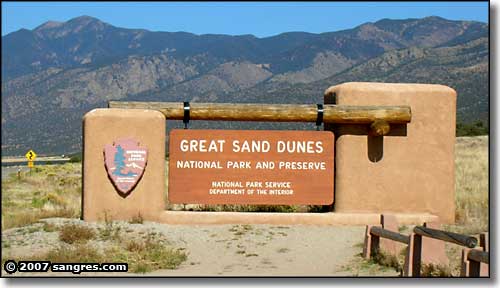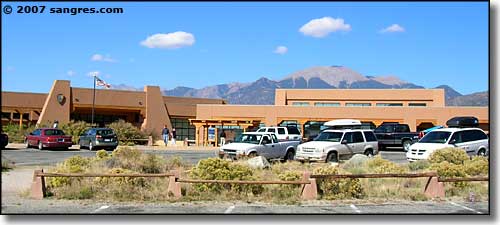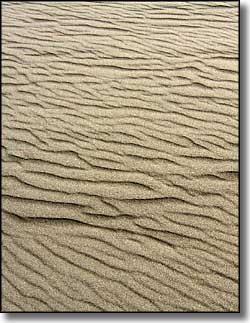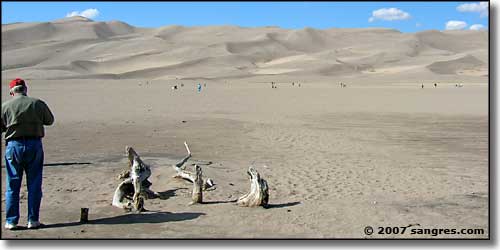
Great Sand Dunes National Park and Preserve

On the eastern side of the remote, high-mountain San Luis Valley, between the Blanca Massif and Crestone Needle, are the Great Sand Dunes, the tallest sand dunes in North America. The dunes cover approximately 39 square miles and rise to almost 750' above the valley floor.
The dunes are the product of the wind and rain eroding the San Juan and Sangre de Cristo Mountains that ring the San Luis Valley. They have collected here because the prevailing winds across the valley blow in this direction and meet winds blowing in the opposite direction. The sand drops to the valley floor and is held in place by water flowing from the Sangre de Cristo's. So over the course of millenia, the dunes have built up to where they are today. And tomorrow they will be different because the wind still blows, the sand still moves and the deposits of sand still grow.
The dunes are like continually changing sculptures. Overall, they maintain a remarkably stable form because they are so moist throughout (from the rain and snow). But the surface layers of sand dry and flow with the wind in ever-changing patterns.
Great Sand Dunes National Monument became Great Sand Dunes National Park and Preserve on September 13, 2004, when Secretary of the Interior Gale Norton signed a declaration making this America's 58th National Park. The Great Sand Dunes National Park and Preserve Act of 2000 mandated the purchase of the 97,000-acre Baca Ranch to create the National Park, the Baca National Wildlife Refuge and to make significant additions to the Rio Grande National Forest. This acquisition occurred through the cooperation of a consortium of private, state and federal partners, including major assistance from the Nature Conservancy. Part of the 103,000-acre Zapata-Medano Ranch (owned and operated by the Nature Conservancy) is included in the National Park and the Baca National Wildlife Refuge.
The Visitor Center is open from 9:00 AM to 6:00 PM, Memorial Day to Labor Day. Hours vary the rest of the year. The newly expanded Visitor Center offers a Great Sand Dunes video presentation, exhibits, an excellent bookstore, first aid room, back porch with viewing scope, and rangers to answer questions and provide assistance.
Accessible restrooms are located at the Visitor Center, Dunes parking lot and the Pinon Flats Campground. The Visitor Center, amphitheater and ranger programs held at these locations are also accessible. A wheelchair designed for the sand can be borrowed from the Visitor Center. Pinyon Flats has 2 accessible campsites and the Sawmill Canyon Backcountry Site offers a graded trail to a tentpad and accessible privy. For more information: contact the Visitor Center.

Great Sand Dunes National Park Visitor Center

Nature walks, short talks and evening programs are offered most days during the summer months and many days in the spring and fall. Free programs for groups may also be reserved in advance by calling 719-378-6399. Topics include geology, plants, wildlife, and history.
Great Sand Dunes offers developed car camping, 4WD backcountry camping and backpacking. Pinyon Flats Campground contains 88 sites with picnic tables and fire grates. There are no hook-ups; restrooms include flush toilets and running water. These sites cost $12.00 per night for a maximum of 6 people and are first-come, first-served. Campsites vary in size and some sites may not accommodate larger RV's. Three sites for groups of 12 or more may be reserved by calling the Visitor Center at 719-378-6399. Group sites cost $3.00 per person per night.
The amphitheater parking lot near the entrance to the campground contains a dumpster, RV dump station, water hose, and air compressor. The dump station and water hose are closed in winter.
Firewood gathering is not permitted: firewood is sold at the Visitor Center or at the Oasis store (just outside the Park entrance). Please pitch tents within rock walls or on tent pads. Quiet hours are from 10:00 PM to 6:00 AM; generators may be run from 7:00 AM to 8:00 PM.

Cleveland and Tijeras Peaks, Music and Marble Mountains rising beyond the dunes
That's Challenger Point, Kit Carson Peak and Columbia Point rising in the distance on the left
Backpacking requires a free permit from the rangers at the Visitor Center. You may camp on the dunes or in one of six designated sites along the Sand Ramp Trail. No open fires are permitted in the backcountry, use stoves instead. Group size is limited to six.
Car camping in the backcountry requires a high-clearance 4WD vehicle. You may camp in first-come, first-served sites along the Medano Pass 4WD Road. This requires a minimum 5 mile drive down a soft sand road.
Bears may be anywhere. Store all food in the trunk or out of sight inside a closed vehicle. Trash must be placed in the central dumpster in the amphitheater parking lot. Do not leave garbage or coolers out at your site.
Leashed pets are welcome outdoors in the park and preserve. They must remain leashed and under control at all times. Do not leave your pet in the car unattended. If you take your pet hiking on the dunes, try to limit your time on the dunes to early morning or early evening when the surface of the sand is cooler. Please clean up after your pets!

The dunes from near the visitor center
Photo Gallery - Maps - Trails to Explore - Ongoing Research
Geology FAQ - Great Sand Dunes Partners
